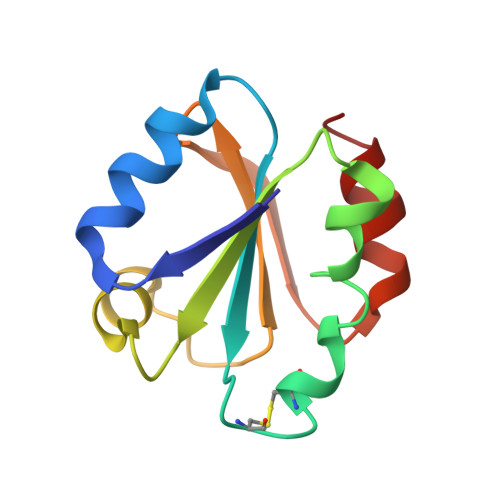The high-resolution three-dimensional solution structures of the oxidized and reduced states of human thioredoxin.
Qin, J., Clore, G.M., Gronenborn, A.M.(1994) Structure 2: 503-522
- PubMed: 7922028
- DOI: https://doi.org/10.1016/s0969-2126(00)00051-4
- Primary Citation of Related Structures:
1TRS, 1TRU, 1TRV, 1TRW - PubMed Abstract:
Thioredoxin is a ubiquitous protein and is involved in a variety of fundamental biological functions. Its active site is conserved and has two redox active cysteines in the sequence Trp-Cys-Gly-Pro-Cys. No structures of the oxidized and reduced states from the same species have been determined at high resolution under the same conditions and using the same methods. Hence, any detailed comparison of the two oxidation states has been previously precluded. The reduced and oxidized states of the (C62A, C69A, C73A) mutant of human thioredoxin have been investigated by multidimensional heteronuclear NMR. Structures for both states were determined on the basis of approximately 28 experimental restraints per residue, and the resulting precision of the two structures is very high. Consequently, subtle differences between the oxidized and reduced states can be reliably assessed and evaluated. Small differences, particularly within and around the active site can be discerned. Overall, the structures of the reduced and oxidized states of the (C62A, C69A, C73A) mutant of human thioredoxin are very similar (with a backbone atomic root mean square difference of about 0.9 A) and the packing of side chains within the protein core is nearly identical. The conformational change between oxidized and reduced human thioredoxin is very small and localized to areas in spatial proximity to the redox active cysteines. These subtle structural differences, in addition to the restriction of conformational freedom within the active site upon oxidation, may be important for the different activities of thioredoxin involving a variety of target proteins.
Organizational Affiliation:
Laboratory of Chemical Physics, National Institute of Diabetes and Digestive and Kidney Diseases, National Institutes of Health, Bethesda, MD 20892.














